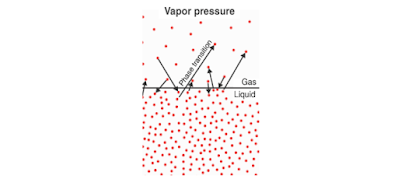If an evacuated container is partially filled with a liquid, a portion of liquid evaporates to fill the remaining volume of the container with vapour.
Initially the liquid evaporates and pressure exerted by vapours on the walls of the container (vapour pressure) increases. After some time it became constant, an equilibrium is established between liquid phase and vapour phase. Vapour pressure at this stage is known as equilibrium vapour pressure or saturated vapour pressure.
Since process of the vapourisation is temperature dependent; the temperature must be mentioned while reporting the vapour pressure of luquid.
When a liquid is heated in an open vessel, the liquid vaporises from the surface. At the temperature at which vapour pressure of the liquid becames equal to the external pressure, vapourisation can occur throughout the bulk of the luquid and vapour expand freely into the surroundings. The condition of free vapourisation throughout the luquid is called boiling.
The temperature at equal to the external pressure of luquid is equal to the external pressure is called boiling temperature at the pressure. Vapour pressure of some common liquids at various temperatures. At 1 atm pressure boiling temperature is called normal boiling point. If pressure is 1 bar then the boiling point is called standard boiling point of the liquid.
Standard boiling point of the luquid is slightly lower than the normal boiling point because 1 bar pressure is slightly less than 1 atm pressure. The normal boiling point of water is 100°C (373K), its standard boiling point is 99.6°C (37.6K).
At high altitudes atmospheric pressure is low. Therefore luquids at high altitudes boil at lower temperatures in comparison to that at sea level. Since water boils at low temperatures on hills, the pressure cooker is used for cooking food. In hospitals surgical instruments are sterilized in autoclaves in which boiling point of water is increased by increasing the pressure above the atmospheric pressure by using a weight covering the vent.
Boiling does not occur when luquid is heated in a closed vessel. On heating continuously vapour pressure increaseses. At first a clear boundary is visible between luquid and vapour phase because luquid is more dense than vapour. As the temperature increases more and more molecules go to vapures rises.
At the same time luquid becames less dense. It expands because molecules move apart. When density of luquid and vapours becomes the same; the clear boundary between liquid and vapours disappears. This temperature is called critical temperature.











